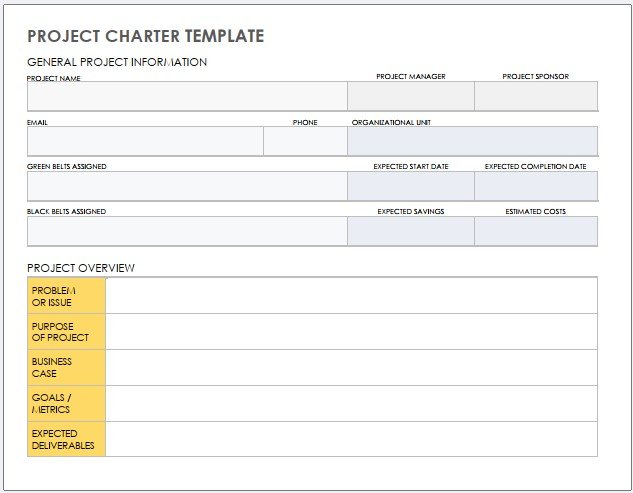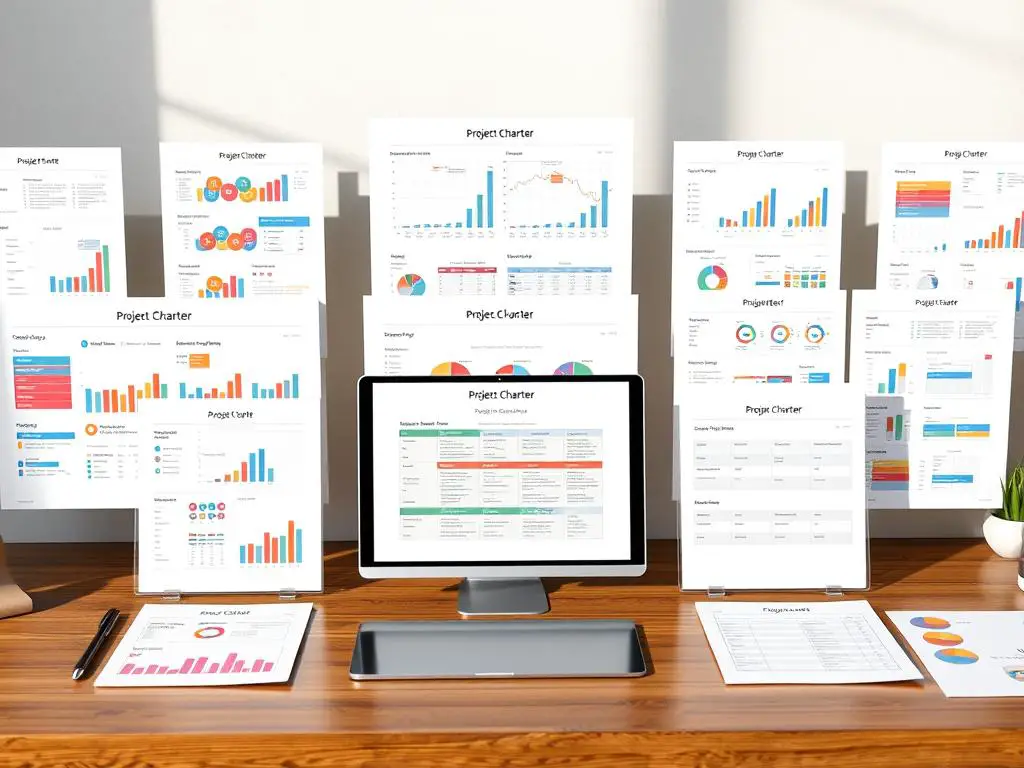Kickstarting a project effectively requires a comprehensive project charter template. This crucial document serves as a roadmap, guiding your team towards successful completion. A well-designed template ensures everyone starts on the same page.
At PMtech Digital Solutions, we recognize the importance of a solid project foundation. Our guide helps you create and utilize a project charter template. This approach streamlines planning and aligns all stakeholders.
Our step-by-step method enables you to develop a compelling project charter. It sells your project to stakeholders and sponsors. Additionally, it provides clear vision and direction for your project team.
A well-crafted project charter sets you up for success from the start. It formalizes the project and grants authority to the project manager. Using a template ensures consistency and completeness in planning.
Key Takeaways
- A project charter is a vital document that formalizes a project and grants authority to the project manager
- Using a project charter template ensures consistency and completeness in project planning
- Key components of a project charter include project name, purpose, objectives, budget, deliverables, scope, risks, timeline, and stakeholder roles
- Collaborating with stakeholders during the project charter creation process is essential for alignment and approval
- The project charter serves as a reference document throughout the project lifecycle, guiding decision-making and keeping the team on track
Understanding the Fundamentals of a Project Charter
A project charter is a vital document for successful project management. It outlines the project’s scope, objectives, and participants. This document serves as a critical tool, defining roles and establishing project goals.
The project charter has three main purposes. It authorizes the project and grants the manager necessary authority. It acts as a sales document, showcasing the project’s value. Lastly, it serves as a roadmap throughout the project lifecycle.
Definition and Purpose of a Project Charter
The project charter is a formal document that outlines key project elements. It defines roles, responsibilities, objectives, and goals. This document is crucial for effective project management and successful execution.
- To authorize the project and grant the project manager the necessary authority to proceed
- To act as a primary sales document, showcasing the project’s value and benefits to stakeholders
- To serve as a roadmap throughout the project lifecycle, providing guidance and direction
Key Components of a Project Charter
An effective project charter includes several key components. These elements ensure a comprehensive overview of the project. They provide clarity and direction for all stakeholders involved.
- Project information and background
- Sponsor and authorizing party details
- Project purpose, goals, and objectives
- Team roles and responsibilities
- Project scope and deliverables
- Timeline and milestones
- Budget and resource allocation
- Risks, constraints, and assumptions
Project goals and objectives differ in their scope and specificity. Goals are high-level benefits the project aims to achieve. Objectives are specific milestones needed to complete those goals. The project scope sets clear boundaries for the project.
Benefits of Using a Project Charter
Using a project charter offers numerous advantages for project management. It enhances communication, alignment, and overall project success. Here are some key benefits of implementing a project charter:
| Benefit | Description |
|---|---|
| Stakeholder Alignment | Aligns stakeholders on the project’s purpose, scope, and objectives, serving as a reference document throughout the project |
| Project Authorization | Secures approval and resources for the project by providing a clear overview and value proposition to stakeholders |
| Clarity of Responsibilities | Acts as a contract between the project sponsor, key stakeholders, and the project team, clarifying everyone’s roles and responsibilities |
Understanding project charter fundamentals is crucial for effective project management. This knowledge equips you to create a comprehensive document. A well-crafted charter sets your project up for success from the start.
Preparing to Create Your Project Charter
Laying the groundwork for your project charter is essential. Gather key information, identify stakeholders, and define objectives and scope. This preparation ensures a comprehensive and effective charter to guide your project successfully.
Gathering Essential Information
Collect crucial details for a solid project charter foundation. Include the project’s name, description, sponsor, manager, team members, and stakeholders. This information streamlines the process and ensures no critical elements are missed.
Identify the project sponsor or authorizing party. This is typically a senior manager with authority to approve and allocate resources. Clear sponsor identification guarantees necessary support for project success.
Determine available resources like budget, tools, and personnel. Understanding these factors helps make informed decisions about scope and timeline. Include these details in your project charter.
Identifying Stakeholders and Their Roles
Identify key stakeholders impacted by the project, both internally and externally. This includes team members, sponsors, customers, and vendors. Early stakeholder engagement provides valuable insights and aligns everyone with project goals.
Define stakeholder roles and responsibilities clearly. This is crucial for the project sponsor, manager, and team members. Setting clear expectations fosters ownership and accountability, leading to better outcomes.
| Stakeholder | Role | Responsibility |
|---|---|---|
| Project Sponsor | Authorizes and oversees the project | Approves project charter, allocates resources, and provides strategic guidance |
| Project Manager | Leads and coordinates the project | Develops project charter, manages team, and ensures project delivery |
| Team Members | Execute project tasks and deliverables | Contribute expertise, complete assigned tasks, and communicate progress |
Defining Project Objectives and Scope
Establish a clear understanding of project objectives and scope. Start by articulating the project’s purpose and expected benefits. Address specific problems or opportunities and align with organizational goals.
Use the SMART method for defining objectives: Specific, Measurable, Achievable, Realistic, and Time-bound. This approach ensures clear direction and easy progress tracking.
“Example SMART Objective: Increase website traffic by 25% within 6 months by implementing an SEO strategy and creating high-quality content.”
Create a project scope statement defining what is and isn’t part of the project. This sets clear boundaries and prevents scope creep. Ensure everyone understands what will be accomplished during the project timeline.
With this groundwork complete, you’re ready to select and customize the right template. Your comprehensive project charter will guide your project effectively towards success.
Choosing the Right Project Charter Template
Selecting the right project charter template is crucial for project success. A well-chosen template streamlines the creation of a comprehensive charter. It effectively communicates goals, scope, and expectations to all stakeholders involved.
Types of Project Charter Templates
Various project charter templates cater to different requirements and methodologies. Common types include simple, Agile, Six Sigma, construction, one-page, and business case templates.
- Simple project charter template: A straightforward, no-frills template that covers the essential components of a project charter.
- Agile project charter template: Designed specifically for Agile projects, this template focuses on iterative development and emphasizes flexibility and collaboration.
- Six Sigma project charter template: Tailored for projects that aim to minimize waste, reduce costs, and enhance competitive market position through the Six Sigma methodology.
- Construction project charter template: Customizable templates that allow for itemization of labor rates, quantity, and line-by-line total amounts, ensuring accurate budgeting and resource allocation.
- One-page project charter template: A concise template that condenses the essential elements of a project charter into a single page for quick reference and easy distribution.
- Business case project charter template: Combines the elements of a project charter with a business case, justifying the project’s value and alignment with organizational goals.
Factors to Consider When Selecting a Template
Choosing the right template involves considering key factors. These ensure alignment with your project’s specific needs and requirements. Essential factors include project size, complexity, and industry-specific requirements.
Consider the project management methodology and customization options. Look for a template that aligns with your approach and allows easy tailoring. Prioritize collaboration and ease of use to encourage participation and buy-in.
- Project size and complexity: Select a template that can accommodate the scale and intricacy of your project, providing sufficient detail without being overly cumbersome.
- Industry-specific requirements: Opt for a template that caters to the unique demands and regulations of your industry, such as construction or healthcare.
- Project management methodology: Ensure the template aligns with your chosen project management approach, such as Agile or Six Sigma, to maintain consistency and facilitate seamless integration.
- Customization options: Look for a template that allows for easy customization, enabling you to tailor it to your project’s specific needs and branding requirements.
- Collaboration and ease of use: Choose a template that promotes collaboration among team members and stakeholders, with a user-friendly format that encourages participation and buy-in.
| Project Charter Template | Key Features | Ideal For |
|---|---|---|
| Project Charter Template | Promotes alignment, clarity, and efficient resource planning | General projects across various industries |
| Program Charter Template | Aids in strategic program management | Construction, IT, and healthcare projects |
| Alignment Chart Template | Aligns project initiatives with organizational goals | Strategic sectors and initiatives |
| Example Project Plan Template | Provides a roadmap for project planning and execution | Ensuring thorough planning from start to finish |
| Project Tracker Template | Offers dynamic project monitoring and deliverable tracking | Timely adjustments and informed decision-making |
| Project Charter Accounting Template | Delivers a detailed framework capturing essential project information | Projects requiring comprehensive financial tracking |
Evaluate available project charter template types carefully. Select a template that best suits your project’s needs. This sets the foundation for a successful and well-organized project.
Customizing Your Project Charter Template
Tailoring your project charter template is crucial for success. It ensures accurate reflection of your project’s needs and aligns with your organization’s branding. Customization creates a unique roadmap for your project’s journey.
Incorporate your organization’s branding elements into the template. Include logos, colors, and fonts to maintain consistency and professionalism. This makes the document easily recognizable as part of your project management process.
Adjust the template’s sections and content to fit your specific project. Standard sections include project overview, objectives, scope, and stakeholders. Add or remove elements as needed to capture all relevant information.
For projects with multiple phases, consider adding a detailed timeline or milestone section. This provides a clear view of the project’s progression and key checkpoints.
“Remember, the goal is to create a comprehensive and informative document that serves as a roadmap for your project’s success.”
Adapt the language to match your organization’s terminology and communication style. This ensures clarity and easy understanding among all stakeholders involved in the project. Clear communication is key to project success.
| Customization Step | Description |
|---|---|
| Branding | Incorporate logos, colors, and fonts to maintain consistency and professionalism |
| Sections and Content | Tailor the template’s sections and content to your project’s specific needs |
| Language | Adapt the language to align with your organization’s terminology and communication style |
A well-customized project charter template becomes a valuable tool for project management. It reflects your organization’s unique identity and approach to project delivery. This customization effort pays off in improved project clarity and direction.
Completing the Project Charter Sections
Let’s explore how to fill out the various sections of a project charter. This document provides a comprehensive overview and roadmap for successful project execution. By carefully completing each section, we ensure a solid foundation for our project.
Project Overview and Justification
Start with a concise project title that captures the essence of your endeavor. Briefly describe the project and the problem it addresses. Align the project’s purpose with organizational goals and objectives. Showcase how it fulfills market, customer, or business needs.
Develop a compelling business case highlighting the project’s value and return on investment. This approach helps secure stakeholder buy-in and support for your initiative.
“According to recent studies, 62% of projects are more successful when they have a well-defined project charter in place, and organizations that consistently use project charters report a 50% increase in project success rates.”
Project Objectives and Deliverables
List quantifiable project objectives using the SMART goal-writing framework. These objectives should signal success upon completion. Specify project deliverables, including products, services, and documentation. Provide detailed information about their features, functionality, and attributes.
Define success metrics to measure progress and outcomes. Ensure these metrics align with the objectives and deliverables you’ve outlined.
Project Scope and Boundaries
Outline what’s included and excluded in the project scope. Be specific about in-scope and out-of-scope items to manage expectations. This clarity helps avoid scope creep, which affects 65% of projects without a charter.
Ensure the project scope aligns with objectives, deliverables, and available resources. This alignment is crucial for project success.
Project Timeline and Milestones
Create a comprehensive schedule outlining start and end dates, key milestones, and deadlines. Include any dependencies that could affect the timeline. Break down the project into manageable phases or sprints.
Assign milestones and deliverables to each phase. This approach provides a clear overview of project progress and critical points.
Project Budget and Resource Allocation
Specify the estimated project budget, including costs for resources, materials, and expenses. Identify assumptions or constraints related to the budget. Allocate resources effectively, considering the project scope, timeline, and deliverables.
Ensure the right people, tools, and budget are assigned to each task or phase. Monitor and manage the project budget throughout its lifecycle. Track expenses and make adjustments to stay within allocated funds.
Project Risks, Assumptions, and Constraints
Identify potential risks like scope creep, resource availability, or external factors. Propose strategies for managing and mitigating these risks. List assumptions made during charter development, such as resource availability or stakeholder capacity.
Outline constraints that may impact the project, like budget limitations or regulatory requirements. Develop plans to work within these constraints effectively.
| Project Charter Section | Key Considerations |
|---|---|
| Project Overview and Justification | Align with strategic goals, develop compelling business case |
| Project Objectives and Deliverables | Use SMART objectives, specify deliverables, and define success metrics |
| Project Scope and Boundaries | Define what is in and out of scope, avoid scope creep |
| Project Timeline and Milestones | Create comprehensive schedule, break down into phases or sprints |
| Project Budget and Resource Allocation | Estimate costs, allocate resources effectively, monitor budget |
| Project Risks, Assumptions, and Constraints | Identify risks, list assumptions, outline constraints, develop mitigation plans |
Collaborating with Stakeholders on the Project Charter
Creating an effective project charter requires active collaboration with stakeholders. Early engagement ensures the charter reflects their needs and expectations. This approach fosters ownership and commitment among stakeholders, leading to better project outcomes.
Seeking Input and Feedback
Schedule meetings or workshops to discuss the project charter’s contents. These sessions clarify questions, address concerns, and gather additional insights. By seeking stakeholder input, we create a charter tailored to specific needs and project objectives.
Utilize tools like Google Docs or Microsoft Office 365 for real-time feedback. Project management software such as Smartsheet or Trello facilitates ongoing communication. These tools help assign tasks and track progress throughout the charter development process.
Incorporating Changes and Refinements
Review and incorporate stakeholder suggestions into the project charter. Make necessary changes to align with expectations and requirements. Document all modifications, including reasons, dates, and involved stakeholders, to maintain transparency and accountability.
| Change Description | Date | Stakeholders Involved | Impact on Project |
|---|---|---|---|
| Revised project timeline | June 15, 2023 | Project Manager, Client Representative | Extended project duration by 2 weeks |
| Added new deliverable | July 1, 2023 | Project Manager, Development Team Lead | Increased project scope and budget |
| Updated risk assessment | July 10, 2023 | Project Manager, Risk Management Team | Identified and mitigated new project risks |
Communicate charter updates to all stakeholders after incorporating feedback. Highlight specific modifications and their impact on scope, timeline, budget, or deliverables. Keep stakeholders informed throughout the process to foster collaboration and ensure alignment towards common goals.
“Effective stakeholder collaboration on the project charter lays the foundation for a successful project by aligning expectations, fostering communication, and ensuring that the project is well-defined and supported by all stakeholders.”
Finalizing and Approving the Project Charter
The final stages of creating a project charter require careful attention. Ensuring completeness and accuracy is vital before seeking approval. A thorough project charter review guarantees quality assurance and a comprehensive completeness check. This process helps identify and address gaps or inconsistencies before stakeholder sign-off.
Data shows that 90% of project charters need sponsor approval. This emphasizes the need for a well-structured document meeting stakeholder expectations. Project management software like ClickUp can streamline this process. Such tools enhance efficiency and effectiveness, increasing the chances of successful project initiation.
Reviewing the Project Charter for Completeness
A thorough examination of each section ensures all necessary information is included clearly. This check should cover project overview, objectives, deliverables, scope, timeline, budget, risks, assumptions, and constraints. Identifying missing or unclear information allows for necessary adjustments to strengthen the charter.
Using a checklist or template can help ensure no essential elements are overlooked. Engaging team members and experts in the review provides valuable insights. This critical project charter review stage creates a solid foundation for project success.
Obtaining Sign-off from Key Stakeholders
After completing the review and revisions, seek formal approval from key stakeholders. This step demonstrates their endorsement and commitment to the project. Schedule a meeting to present the final charter, address questions, and secure approval.
“A recent study shows 85% of project charters are signed and approved by sponsors or stakeholders. This highlights the importance of stakeholder sign-off for project success.”
Be prepared to discuss key elements like objectives, scope, timeline, budget, and expected outcomes. Encourage open dialogue and listen to stakeholder feedback. Document the sign-off process, including date, names, and titles of those who endorsed the charter.
Obtaining stakeholder sign-off demonstrates commitment to transparency and effective project management. This milestone marks the transition from planning to execution. It sets the stage for a successful project aligned with organizational goals.
Using the Project Charter Throughout the Project Lifecycle
The project charter guides the team throughout the entire project lifecycle. It serves as a roadmap, aligning everyone with the project’s objectives and scope. This tool keeps the project on track and helps achieve success.
Communicating the Project Charter to the Team
Effective charter communication ensures team alignment and a successful project kickoff. Share the charter’s contents with the entire project team after approval. This helps everyone understand the project’s goals, scope, timeline, and budget.
Hold a kickoff meeting to review the charter with the team. Answer questions and clarify ambiguities to establish a shared understanding. This fosters a sense of ownership and commitment to the project’s success.
Store the charter in a central location for easy access. Use a project management tool or shared drive so team members can refer to it when needed.
Referencing the Project Charter for Guidance and Decision-Making
The charter serves as a valuable reference throughout the project lifecycle. When faced with challenges or decisions, consult the charter to align actions with objectives. Use it to manage expectations and prevent scope creep when stakeholders request changes.
“The project charter acts as a guiding North Star, helping the team stay focused on the project’s goals and make informed decisions along the way.”
Consistent reference to the charter maintains clarity and avoids misunderstandings. It ensures team efforts remain aligned with the project’s overall direction.
Updating the Project Charter as Needed
Projects can evolve over time, requiring updates to the charter. Follow a formal change management process to handle modifications effectively. Document proposed changes and assess their impact on objectives, resources, and timeline.
Obtain stakeholder approval before implementing any modifications. Update the charter to reflect approved changes and communicate updates to the team. This maintains the charter’s integrity as a reliable guide throughout the project’s evolution.
- Document the proposed changes and their rationale.
- Assess the impact of the changes on the project’s objectives, resources, and timeline.
- Obtain approval from the appropriate stakeholders before implementing any modifications.
- Update the project charter to reflect the approved changes.
- Communicate the updates to the team and stakeholders, ensuring everyone is aware of the changes and their implications.
| Project Phase | Project Charter Usage |
|---|---|
| Initiation | Communicate charter to team, hold kickoff meeting |
| Planning | Reference charter for guidance, align plans with objectives |
| Execution | Consult charter for decision-making, manage scope |
| Monitoring & Controlling | Update charter as needed, assess impact of changes |
| Closing | Evaluate project against charter, document lessons learned |
Leveraging the project charter throughout the lifecycle maintains focus and enables informed decisions. It allows adaptation to changes while keeping the project aligned with its original purpose and goals.
Conclusion
A well-crafted project charter is essential for project success. It sets the foundation by documenting critical aspects of the project. At PMtech Digital Solutions, we recognize the charter’s importance in guiding successful project management.
The charter serves as a vital reference point throughout the project lifecycle. It aligns team members and stakeholders on objectives, scope, deliverables, and timeline. Regular review helps teams make informed decisions and adapt to changes.
A project charter is a living document that should be updated as needed. It reflects significant changes or decisions made during the project. This ensures everyone stays aligned with the organization’s strategy and objectives.
With a strong charter, teams can work together more effectively. They can overcome challenges and drive business value through successful project delivery. Maintaining a dynamic charter keeps everyone on the same page throughout the project.










